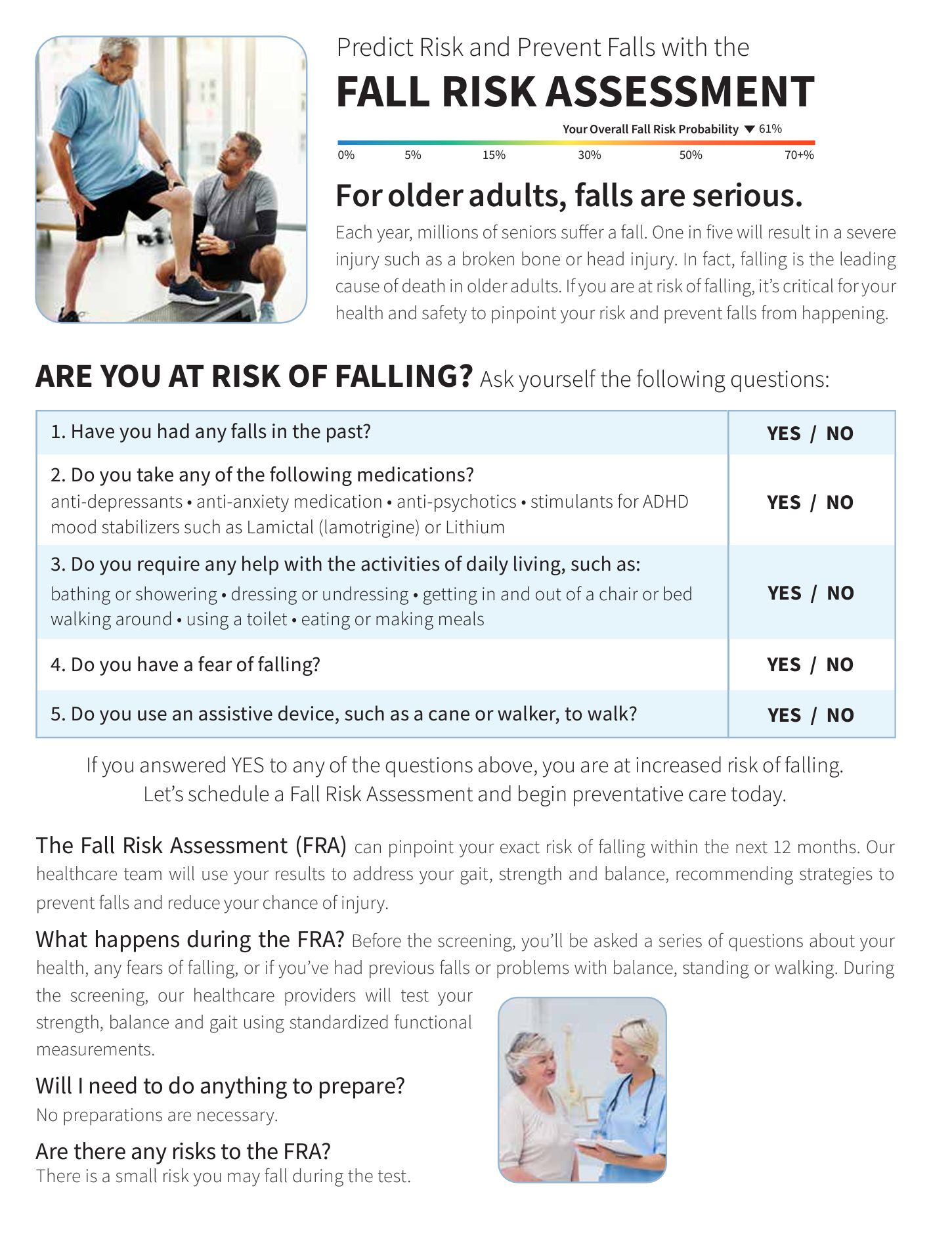Dementia Fall Risk Fundamentals Explained
Not known Facts About Dementia Fall Risk
Table of ContentsThe 15-Second Trick For Dementia Fall RiskThe Greatest Guide To Dementia Fall RiskThe Definitive Guide for Dementia Fall RiskSee This Report on Dementia Fall Risk
An autumn threat analysis checks to see just how most likely it is that you will certainly fall. It is mostly provided for older adults. The evaluation typically consists of: This consists of a collection of inquiries regarding your general wellness and if you have actually had previous falls or troubles with equilibrium, standing, and/or walking. These tools examine your strength, equilibrium, and stride (the means you stroll).STEADI consists of screening, analyzing, and treatment. Interventions are suggestions that might lower your danger of dropping. STEADI includes 3 actions: you for your danger of dropping for your danger variables that can be boosted to attempt to avoid falls (as an example, balance troubles, damaged vision) to reduce your risk of dropping by making use of efficient approaches (for example, giving education and sources), you may be asked numerous questions including: Have you fallen in the previous year? Do you really feel unstable when standing or strolling? Are you stressed over falling?, your provider will test your stamina, equilibrium, and gait, utilizing the following autumn analysis tools: This test checks your gait.
You'll sit down again. Your service provider will check exactly how lengthy it takes you to do this. If it takes you 12 seconds or more, it might mean you are at greater risk for a loss. This examination checks stamina and balance. You'll being in a chair with your arms went across over your upper body.
Move one foot midway onward, so the instep is touching the large toe of your other foot. Move one foot totally in front of the various other, so the toes are touching the heel of your various other foot.
See This Report about Dementia Fall Risk
A lot of falls take place as a result of multiple adding factors; consequently, handling the risk of dropping starts with identifying the elements that add to drop threat - Dementia Fall Risk. Some of the most appropriate danger elements consist of: Background of prior fallsChronic clinical conditionsAcute illnessImpaired stride and balance, lower extremity weaknessCognitive impairmentChanges in visionCertain risky medicines and polypharmacyEnvironmental variables can additionally raise the threat for falls, consisting of: Poor lightingUneven or harmed flooringWet or slippery floorsMissing or damaged hand rails and order barsDamaged or improperly equipped tools, such as beds, wheelchairs, or walkersImproper use assistive devicesInadequate supervision of individuals living in the NF, consisting of those that exhibit hostile behaviorsA effective autumn danger administration program needs a comprehensive scientific evaluation, with input from all participants of the interdisciplinary group

The treatment strategy should additionally consist of treatments that are system-based, such as those that promote a secure atmosphere (suitable lights, hand rails, get hold of bars, and so on). The effectiveness of the interventions ought to be assessed regularly, and the care plan modified as essential to show modifications in the fall threat evaluation. Carrying out a fall threat administration system using evidence-based best practice can decrease the occurrence of drops in the NF, while restricting the capacity for fall-related injuries.
Rumored Buzz on Dementia Fall Risk
The AGS/BGS guideline suggests evaluating all grownups matured 65 years and older for autumn risk every year. This screening includes click now asking people whether they have actually dropped 2 or even more times in the past year or looked for medical attention for a fall, or, if they have not fallen, whether they really feel unsteady when walking.
Individuals that have fallen as soon as without injury should have their equilibrium and gait reviewed; those with gait or equilibrium abnormalities ought to obtain added analysis. A background of 1 loss without injury and without stride or equilibrium troubles does not warrant further analysis beyond ongoing yearly fall risk screening. Dementia Fall Risk. A loss risk evaluation is called for as component of the Welcome to Medicare evaluation

What Does Dementia Fall Risk Do?
Documenting a drops background is one of the quality indicators for loss prevention and administration. copyright medicines in particular are independent forecasters of falls.
Postural hypotension can typically be minimized by decreasing the dosage of blood pressurelowering medications and/or quiting medicines that have orthostatic hypotension as a negative effects. Use above-the-knee support pipe and copulating the head of the bed elevated may additionally reduce postural decreases in high blood pressure. The preferred aspects of a fall-focused checkup are received Box 1.

A Yank time higher than or equal to 12 secs suggests high fall danger. click to investigate Being unable to stand up from a chair of knee height without utilizing one's arms indicates raised autumn danger.